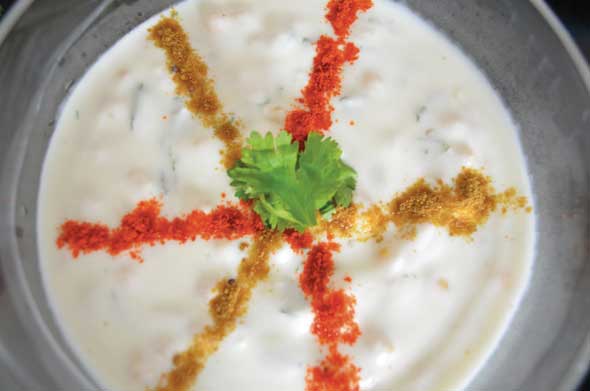Mama’s Punjabi Recipes: Baingan Da Raita (Eggplant Yogurt Sauce)
Eggplants are very popular in India and especially in the North where the most popular dish is baingan bhartha which is cooked with lots of onions; some people even add peas for added taste.
Yogurt has a special significance in Indian culture and religion. It is considered sacred and a purifying agent because of the relationship of cowmilk with many Hindu rituals and because yogurt, or curds as many Indian call it, were eaten up by the baby Lord Krishna.
Raita or yogurt sauce is a byproduct of yogurt and is eaten all over India to complement and soften the taste – and sometimes the spiciness – of many Indian dishes. Raita must have the right consistency so that it doesn’t run all over the plate and can be eaten with roti, paranthas or chawal (rice).
Raita is a quick dish to make and when made with vegetables can take the place of a salad. There are many types of raita to choose from when deciding on a complement to an Indian meal and the choice often comes down to the effect that you want to achieve with the food. For example, if the food is very spicy and served with roti, then a pudina (mint leaf) raita is probably best to soothe the mouth as the spices go down.
When you mix the two together, the bland taste of baingan is enveloped by the raita and other ingredients into an appetizing dish. Baingan raita is never found in restaurants, so many younger people have no idea what it tastes like. But the closest they get to it is the Mediterranean dip, Baba Ghanoush, but it contains no yogurt.
Ingredients:
• 500gm saddi dahin (plain yogurt)
• 1 medium baingan (eggplant)
• ½ cup doodh (milk)
• Spices to taste: namak (salt), mirch (red pepper)
Directions:
1. Remove the top dandal (stem) off the eggplant, peel it and then cut it lengthwise into slices. Cut the slices into smaller 1.5 inch pieces.
2. Wash the pieces in cold water and let them drain in a strainer. It is very important to wash them otherwise the eggplant will start to turn dark.
3. Heat the oil in a skillet, wok or kadai, place the eggplant in it and mix till they are coated. Cover and let cook for 10 minutes. Check to see that the eggplant has become tender. If it has, then mash the eggplant with a large spoon: do not use a mixer as the eggplant should not be pureed.
4. Leave to cook for 2 more minutes, then take off the heat and let it cool for 30 minutes.
5. Place the dahi in a bowl and stir it thoroughly with a spoon, adding the milk to it. Add the salt and pepper to taste.
6. Gently stir in the mashed eggplant. Chill for 10 minutes and serve.
MAMA’S TIP OF THE WEEK
HOW TO CHOOSE A BAINGAN (EGGPLANT) TO COOK BHARTA
For most eggplant dishes and especially bharta (pureed eggplant), the choice of the vegetable is very important for the texture, taste and ease of cooking as well as if the final dish will be tough or soft to eat. Usually you don’t want to have a dish with lots of seeds as they distract the palate from the softness of the main dish and you will spit them out.
It is best to choose a large round eggplant that is not heavy: a heavy one means that it has a lot of seeds. A slightly tender, round eggplant is the best, but most times you will find elongated ones. Still, choose the one that is tender but does not collapse when squeezed. Also, the green stem (dandal) should not have any dark spots on it. When cut off with the top portion of the eggplant and cooked correctly, the skin and base of the stem are very edible and tasty.

Shakuntla Malhotra is a skilled cook of Punjabi dishes made in the old-fashioned style that she learnt as a young woman in her ancestral home in Lyallpur (since renamed Faisalabad), India before it became part of Pakistan after the Partition in 1947. People have often admired her cooking for its simplicity and taste that comes with each mouthful. Even in her mid-eighties, she continues to cook daily and agreed to share some of her delectable Punjabi recipes.

